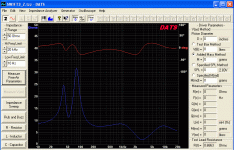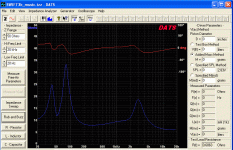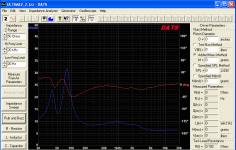I've noticed that many 8 ohm (nominal impedance) woofers have RE 6.x, while others are as low as RE5 (a big percentage difference) yet are still described as 8ohm impedance. I'm wondering what implications there might be from a lower RE vis-à-vis the amplifier. It's been suggested elsewhere that RE isn't crucial in the relationship to the amplifier - and that one only need consider impedance at audio frequencies. That seems too easy, though - and since when is anything easy in audio?  So, I'd be interested and grateful to have some 'second opinions' on this, especially from folks who've built amps as well as speakers. Thanks in advance.
So, I'd be interested and grateful to have some 'second opinions' on this, especially from folks who've built amps as well as speakers. Thanks in advance.
Last edited:
Although speaker impedance varies wildly (and that´s an understatement) across the Audio range, it becomes very close to DC resistance at low mid frequencies, think between 250 and 400 Hz, and also there is a lot of program material there, so a lower DC resistance one will BE an important load for the amp driving it.
Maybe not that much as overheatingf it, but quite often triggering the short circuit protection, which gives out objectionable buzzy distortion.
So on some tightly protected amps, a too low DC resistance speaker *may* be a problem.
That said, an immensely popular Musical Instrument speaker maker which I won´t name, routinely makes nominally 8 ohms speakers with 5 ohms DC coils, I have measured that countless times, I guess to justify their inflated dB/W sensitivity ratings.
Oh well.
Maybe not that much as overheatingf it, but quite often triggering the short circuit protection, which gives out objectionable buzzy distortion.
So on some tightly protected amps, a too low DC resistance speaker *may* be a problem.
That said, an immensely popular Musical Instrument speaker maker which I won´t name, routinely makes nominally 8 ohms speakers with 5 ohms DC coils, I have measured that countless times, I guess to justify their inflated dB/W sensitivity ratings.
Oh well.
The minimum impedance can dip to one half of the rated impedance in a loudspeaker according to the standard. Many amplifier manufacturers rate their amplifiers for resistive loads.
So if you have an 8 ohm loudspeaker the amplifier needs to be rated for a 4 ohm load. Usually not a problem. What does pop up is loudspeakers rated for 4 ohms or driving two 8 ohm loudspeakers in parallel. Many amplifiers cannot drive a 2 ohm load.
So if you have an 8 ohm loudspeaker the amplifier needs to be rated for a 4 ohm load. Usually not a problem. What does pop up is loudspeakers rated for 4 ohms or driving two 8 ohm loudspeakers in parallel. Many amplifiers cannot drive a 2 ohm load.
Re is the DC resistance of the voice coil. It is one of the parameters in Thiele & Small measurements.
Re does not indicate the lowest impedance of a loudspeaker. For that, you'll need to do an impedance sweep. From the plot, you can then determine the lowest point.
Like simon mentioned, amplifiers are rated into resistive loads. Loudspeakers are reactive by nature. To compound the problem, most loudspeakers are not linear phase. The demands on a power amplifier is therefore much more taxing.
A loudspeaker rated at 8 ohms (nominal) can safely be driven with an amplifier rated to 4 ohms. When you parallel two 8 ohms drivers, it goes down to 4 ohms. To be on the safe side, your amplifier needs to be able to drive 2 ohm loads.
Re does not indicate the lowest impedance of a loudspeaker. For that, you'll need to do an impedance sweep. From the plot, you can then determine the lowest point.
Like simon mentioned, amplifiers are rated into resistive loads. Loudspeakers are reactive by nature. To compound the problem, most loudspeakers are not linear phase. The demands on a power amplifier is therefore much more taxing.
A loudspeaker rated at 8 ohms (nominal) can safely be driven with an amplifier rated to 4 ohms. When you parallel two 8 ohms drivers, it goes down to 4 ohms. To be on the safe side, your amplifier needs to be able to drive 2 ohm loads.
Re is not relevant, as amplifiers should never send dc to a loudspeaker. You should indeed only consider impedance (both magnitude and phase) in the audio band. Below the audio band nothing is sent to the speaker, above the audio band loudspeaker impedance usually goes up. The exceptions are some crossover-less loudspeakers with piezo tweeters, which almost act like a capacitor at supersonic frequencies. Some amplifiers become unstable with such a load and start oscillating.
What standard?The minimum impedance can dip to one half of the rated impedance in a loudspeaker according to the standard.
Last edited:
For most of DIY readers, Re is really only useful to troubleshooting for telling you if a coil has opened or shorted. As pointed out above, Amplifiers shouldn't be putting out DC, so Re should be irrelevant.
However! That's an incomplete answer. If you are simulating an amplifier, and you wanted to simulate the amplifier with simulated speakers you would use Re indirectly in a speaker driver model. Here is the commonly used URL="http://www.shine7.com/audio/orcad.htm"]and (for us) complicated electrical models[/URL].
Speaker designers however would measure the Z or copy it from spec sheets and assume the amplifier to be ideal within the design parameters of the speaker.
Best,
Erik
However! That's an incomplete answer. If you are simulating an amplifier, and you wanted to simulate the amplifier with simulated speakers you would use Re indirectly in a speaker driver model. Here is the commonly used URL="http://www.shine7.com/audio/orcad.htm"]and (for us) complicated electrical models[/URL].
Speaker designers however would measure the Z or copy it from spec sheets and assume the amplifier to be ideal within the design parameters of the speaker.
Best,
Erik
even for AC signal a resistive load is easiest on the amp, a resistive load is what nominal design equations assume
phase of the load makes a large difference in power dissipation in the output stage
SOA stress on Second Breakdown limited Power BJT is increased for reactive load too
in multiway loudspeakers some impedance dips may come from odd passive XO choices
phase of the load makes a large difference in power dissipation in the output stage
SOA stress on Second Breakdown limited Power BJT is increased for reactive load too
in multiway loudspeakers some impedance dips may come from odd passive XO choices
Zoodle
There's more to just Re.
Here are three plots of a speaker I worked on some time back. A 2-way design using ZA14 for mid-woofer and a Vifa XT25TG30-04 tweeter.
In the first plot, the impedance dips to 2 ohms at about 3K. This is a very "unfriendly" load for power amplifiers.
The next plot is much better. Lowest impedance is about 6 ohms at about 20K.
The plot on the extreme right shows less fluctuations on the impedance. More importantly is the phase. It is almost linear from 500Hz to 20KHz.
Same woofer, same tweeter but different crossovers.
There's more to just Re.
Here are three plots of a speaker I worked on some time back. A 2-way design using ZA14 for mid-woofer and a Vifa XT25TG30-04 tweeter.
In the first plot, the impedance dips to 2 ohms at about 3K. This is a very "unfriendly" load for power amplifiers.
The next plot is much better. Lowest impedance is about 6 ohms at about 20K.
The plot on the extreme right shows less fluctuations on the impedance. More importantly is the phase. It is almost linear from 500Hz to 20KHz.
Same woofer, same tweeter but different crossovers.
Attachments
Re does not indicate the lowest impedance of a loudspeaker.
It sounds wired to me. Could you please explain it more? As far as I know, to reach an impedance lower than DC resistance the speaker needs to move at least 120deg. out of phase with the source which no speaker can do. Does it have something to do with the crossover? And what is it in simple language?
Thanks
When you use a meter and measure the resistance across a woofer terminals, that is your Re, the resistance of the voice coil.
Speakers are normally specified as a nominal impedance. What that loosely mean is like average. To see how demanding a speaker is for a power amp, do an impedance sweep.
In the three impedance plots of the same speaker I showed above, you can see how the impedance changes with different crossovers. It is these impedance and phase that affect power amplifiers.
Speakers are normally specified as a nominal impedance. What that loosely mean is like average. To see how demanding a speaker is for a power amp, do an impedance sweep.
In the three impedance plots of the same speaker I showed above, you can see how the impedance changes with different crossovers. It is these impedance and phase that affect power amplifiers.
A belated big thank you for all your replies. What's the best way to measure impedence across the audio and range? I have 'Woofer Tester 2' - could I use that to sweep a complete speaker system? I've also read a Rod Elliot article describing a method using a voltmeter(?)and a spreadsheet from his site. What are you folks using?
Typically Re is about 70% of the rated impedance, hence you find a large number of 8 ohm and 4 ohm rated drivers clustered at 5.6 and 2.8 ohms DC. At the minimum above the bass peaks, the impedance will usually be slightly (~10%) higher.
Your woofer tester will generate an impedance curve and show you magnitude and phase. When phase gets more than 50-60 degrees, the load is said to be reactive and is more strenuous on the amplifier.
Rated or nominal impedance is whatever the manufacturer wants to put on the speaker. I own a speaker with all "4 ohm" drivers (the bass driver is 2.8 ohms DC) that is rated by the mfg as "6 ohm" - perhaps because it is 94dB sensitive.... I have driven these speakers to surprising levels with a portable cassette player
If you have a cheap amp and want to drive at normal listening levels (a watt or less RMS for most speakers), impedance probably doesn't matter much. If you want to host a dance party, I would go with the lowest of DC resistance of the drivers, or impedance of the completed speakers, (whichever is lower) as a guide.
Your woofer tester will generate an impedance curve and show you magnitude and phase. When phase gets more than 50-60 degrees, the load is said to be reactive and is more strenuous on the amplifier.
Rated or nominal impedance is whatever the manufacturer wants to put on the speaker. I own a speaker with all "4 ohm" drivers (the bass driver is 2.8 ohms DC) that is rated by the mfg as "6 ohm" - perhaps because it is 94dB sensitive.... I have driven these speakers to surprising levels with a portable cassette player
If you have a cheap amp and want to drive at normal listening levels (a watt or less RMS for most speakers), impedance probably doesn't matter much. If you want to host a dance party, I would go with the lowest of DC resistance of the drivers, or impedance of the completed speakers, (whichever is lower) as a guide.
I have 'Woofer Tester 2' - could I use that to sweep a complete speaker system?
Yes, that's what it's for. Do an Impedance Sweep from 20Hz-20kHz. Look for the lowest point.
I've also read a Rod Elliot article describing a method using a voltmeter(?)and a spreadsheet from his site.
That's for people who don't have Woofer Tester.
I'm using DATS and LMS.What are you folks using?
- Status
- This old topic is closed. If you want to reopen this topic, contact a moderator using the "Report Post" button.
- Home
- Loudspeakers
- Multi-Way
- DC resistance vs rated impedance - is it important to the amplifier?


